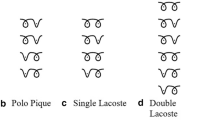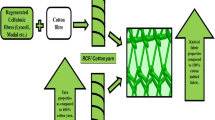Abstract
Recent advances in fibre and yarn technology, coupled with the ever changing lifestyles of the present day consumers, has a considerable bearing on the ‘Product development’ of ‘Novel fabrics.’ Moreover, today’s consumers are becoming more and more conscious, in terms of fabric quality, design, performance and aesthetic attributes in a product and are on the constant look out for ‘Newer’ fabrics of their choice. In the present work, the use of cotton in blends with the polyester trilobal filament yarn in conjunction with plain and sateen weave designs on certain engineered commercially used poplin, cambric and crepe constructions have resulted in the development of a set of ‘Novel fabrics’ for the consumer. The effect of the direction of ‘S’ and ‘Z’ twist yarns and their various arrangement and groupings of warp and weft threads in fabrics have brought out interesting results in the formation of special ‘Warp ribbed’, ‘Shadow’ and ‘Crepe’ like fabric structures. Only, polyester component dyeing in these cotton-rich (67-33, C:P) blend samples has provided the option of producing lighter shaded shirtings and suitings economically as per the consumers’ requirement and cross dyeing of cotton part results in the samples has further opened up numerous possibilities of introducing ‘Novel’ effects in such trilobal blend fabrics.





Similar content being viewed by others
References
A.M. Spiro, Woven apparel fabrics. Ind. Eng. Chem. 44, 2151 (1952)
R. Bouvet, Fibre—Fabric relationships, Ibid, 2125
S.V. Bhende, G.S. Prabhu, Why blend ?, Wool and Woollens of India, 12 (1969)
R.N. Kanungo, A study of the effect of weave and construction on the physical properties on mix-woven fabrics. M. Text. Thesis, University of Bombay. 2, 18, March 1970
M. Harris, Some problems of blending. Text. Res. J. 24, 379 (1954)
R.N. Kanungo, Emerging trends in new generation fibres, 65–76, Book of Papers: Proceedings—2nd International Conference of NISTI, 2–3 December 2004, Delhi
S.N. Bhaduri, Technical Seminar on Blending (Textile Association, India, 1965), p. 35
M.C. Holland, Trilobal textile filament, U.S. Patent 2,939,201 (1959a)
H.J. Gefri, T. Largman, F. Mares, Filaments having Trilobal or quadrilateral cross sections, U.S. Patent 5,057,368 (1991)
M. Fukuhara, Innovations in polyester fibres: from silk to new polyester. Text. Res. J. 63, 387–391 (1993)
K. Kajiwara, R. Nori, M. Okamoto, New fibers from Japan, Part 3: Technologies for a new century. J. Text. Inst. 91, 32–78 (2000)
Textile Terms and Definitions, Textile Institute, Manchester, 9th edition (1991)
W. Hough, Encyclopaedia of Cotton Fabrics (John Sherratt & Sons, Aldrincham, 1954)
H. Nisbet, Grammar of Textile Design (Ernst Benn Ltd, London, 1927)
W. Watson, Textile Design and Colour (Longmans Green Publication, New York, 1956)
A. Ormerod, Management of Textile Production (Newnes Butterworth Publication, London, 1979), pp. 28–40
R.M. Hoffmann, R.W. Peterson, Engineering of fabrics from blends with synthetic fibres. J. Text. Inst. 49, 418 (1958)
Acknowledgments
The authors are thankful to Reliance Industries Ltd. Ahmedabad, for their kind support in providing the polyester trilobal filament yarn used in the present study. The authors also wish to express their indebtedness to the technical staff of M/s Arvind Ltd. Santej and M/s Ankur Textiles, Ahmedabad, who have rendered their invaluable cooperation in conducting certain mill trials in the present work. The authors gratefully wish to acknowledge the continued patronage of former Honorary Secretary. Textile Association, Ahmedabad Unit, throughout the preparation of the paper.
Author information
Authors and Affiliations
Corresponding author
Rights and permissions
About this article
Cite this article
Kanungo, R.N., Shukla, S.K. Effect of Yarn Twist Direction and Woven Design on Certain Novelty Fabrics from Cotton/Polyester Trilobal Filament 3-ply Yarn. J. Inst. Eng. India Ser. E 96, 15–21 (2015). https://doi.org/10.1007/s40034-015-0064-2
Received:
Accepted:
Published:
Issue Date:
DOI: https://doi.org/10.1007/s40034-015-0064-2




